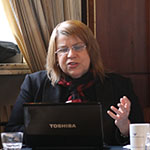Euroacademia Conferences
 Europe Inside-Out: Europe and Europeanness Exposed to Plural Observers (9th Edition) April 24 - 25, 2020
Europe Inside-Out: Europe and Europeanness Exposed to Plural Observers (9th Edition) April 24 - 25, 2020 Identities and Identifications: Politicized Uses of Collective Identities (9th Edition) June 12 - 13, 2020
Identities and Identifications: Politicized Uses of Collective Identities (9th Edition) June 12 - 13, 2020 8th Forum of Critical Studies: Asking Big Questions Again January 24 - 25, 2020
8th Forum of Critical Studies: Asking Big Questions Again January 24 - 25, 2020 Re-Inventing Eastern Europe (7th Edition) December 13 - 14, 2019
Re-Inventing Eastern Europe (7th Edition) December 13 - 14, 2019 The European Union and the Politicization of Europe (8th Edition) October 25 - 26, 2019
The European Union and the Politicization of Europe (8th Edition) October 25 - 26, 2019 Identities and Identifications: Politicized Uses of Collective Identities (8th Edition) June 28 - 29, 2019
Identities and Identifications: Politicized Uses of Collective Identities (8th Edition) June 28 - 29, 2019 The European Union and the Politicization of Europe (7th Edition) January 25 - 26, 2019
The European Union and the Politicization of Europe (7th Edition) January 25 - 26, 2019 7th Forum of Critical Studies: Asking Big Questions Again November 23 - 24, 2018
7th Forum of Critical Studies: Asking Big Questions Again November 23 - 24, 2018 Europe Inside-Out: Europe and Europeanness Exposed to Plural Observers (8th Edition) September 28 - 30, 2018
Europe Inside-Out: Europe and Europeanness Exposed to Plural Observers (8th Edition) September 28 - 30, 2018 Identities and Identifications: Politicized Uses of Collective Identities (7th Edition) June 14 - 15, 2018
Identities and Identifications: Politicized Uses of Collective Identities (7th Edition) June 14 - 15, 2018
Gothic Plots and Political Anxieties: Kapka Kassabova’s Reconnaissance and Elizabeth Kostova’s The Historian
-
-

-
Presentation speakers
- Ludmilla Kostova, University of Veliko Turnovo, Bulgaria
Abstract:
Gothic writing has long been seen as a site dominated by anxieties over the definition of political, social, cultural and sexual boundaries and the identities of such boundaries’ transgressors. Predictably, fictional representations of Eastern Europe and its denizens have frequently been cast in the Gothic mode. This refers to both Gothic narratives by nineteenth- and twentieth-century Western writers and to work by “native” litterateurs. The presence of Gothic elements in Eastern European literary contexts, from the nineteenth century onwards, was apparently so pervasive that not even drastic measures by the region’s communist governments, such as “the reorganization and standardization of fiction under the banner of ‘Socialist Realism’” (Muireann Maguire), could effectively prevent some of the genre’s textual “revenants” from “haunting” the vigilantly policed terrain of literary production (see Muireann Maguire, “’A Dreadful Predilection’. The Gothic Fantastic in Soviet Socialist Realist Literature,” Gothic Studies 13.1, May 2011, pp.75-94). Following the collapse of Soviet-style totalitarian governments in 1989 and the early 1990s, the Gothic mode experienced a revival in most eastern European literatures. On the other hand, in Anglophone countries, Gothic elements could be discerned in mass media and literary representations of the downfall of communist regimes in Eastern Europe and the ensuing transition to liberal democracy and market economic formats. As a result, Gothic images participated in the post-Cold War (re)invention of the political and cultural-symbolic parameters of a wide range of Eastern European localities.
My presentation focuses on two novels, Reconnaissance (1999), by Bulgarian-born writer and poet Kapka Kassabova, and The Historian (2005), by US-American writer Elizabeth Kostova. Both texts employ the representational logic and plot mechanics of Gothic as they attempt to account for historical developments and political events in Eastern Europe and their impact upon individual human destinies. Kassabova’s book can be read as an example of what Roger Luckhust has termed “trauma Gothic” (The Trauma Question, Routledge, 2008, pp. 97-105) as it portrays a deeply troubled heroine whose journey through New Zealand climaxes in the revelation of a morally dubious legacy rooted in Bulgaria’s communist past. The plot of The Historian spans a truly global terrain which comprises Istanbul, parts of Romania, Bulgaria and Hungary, Western Europe and the United States. This terrain serves as a playground on which the Wallachian arch-vampire Dracula enacts his overwhelming desire for power, while showing total disregard for the lives and feelings of others. Through him Eastern European primitivism atavistically erupts and affects the world at large. In the context of the book, containing the monster is recognized as a task of paramount importance but the conservative reassertion of “proper” boundaries appears increasingly problematic as the narrative draws to a close. Apart from highlighting some of the two texts’ major themes and dwelling on the significance of Eastern Europe’s past(s) in them, I will reflect upon their place in the overall context of post-Cold War Gothic writing.
-
Related Presentations

EU vs Western Balkans: Life on the Margins of a Great Community
- Ivana Božić Miljković

Outside the Stadium
- Michal Krajkowski
















